Uncover Bergerac's vibrant flavors and culinary gems with our expert guides. Plan an unforgettable trip now!
Read more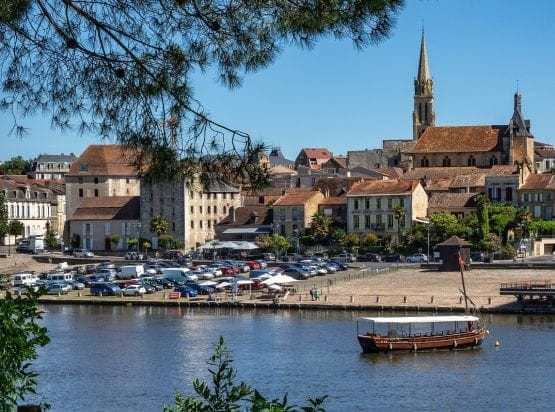
EXPLORE ALL OUR SOUTH WEST FRANCE WINE REGION GUIDE
Last updated: April 4, 2025
Long colonized by expats and weekend Parisians, Bergerac remains one of the most popular parts of southwestern France. Indeed, its attractions are obvious and numerous: superlative gastronomy, chocolate-box towns, and the bucolic splendor of unspoiled, rolling countryside. Little wonder the English desperately attempted to maintain their hegemony over the region (unsuccessfully) during the Hundred Years’ War.
Yet the wines of Bergerac have, until recently, been largely ignored by the globe-trotting wine glitterati, lazily derided as a “decent alternative to Bordeaux.” Although many of the key grape varieties are the same, the wines of the Dordogne have their own distinct identity—differences in terroir and climate bring this about.
The truth is that Bergerac is far more than simply a clone of its larger neighbor. It is, therefore, worthy of further investigation.
Discover More About French Wine
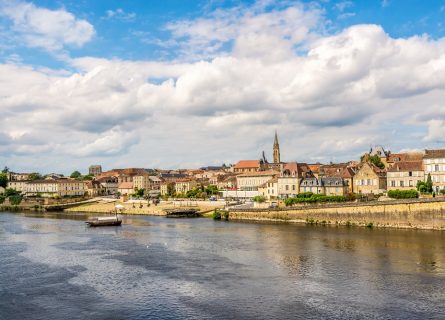
The town of Bergerac was not founded until the 11th century – a small settlement attached to a castle that sadly no longer exists. However, the Dordogne has been inhabited for centuries; Cro-Magnon man endowed the area with the most spectacular series of prehistoric cave paintings in Europe, including the legendary Grotte de Lascaux near Montignac.
Many centuries later, in 51 BC, the Romans planted their flag on the hills of the Dordogne, establishing the rich and prosperous city of Bordeaux in Aquitania. The Roman Patrician class planted vines along the valley and south of Bordeaux, and the Atlantic trade generated great wealth for them.
Shifting Powers and Influence
However, the Visigoths conquered Aquitania in the late 5th century following the disintegration of the Western Roman Empire. Yet these Germanic invaders had little hope of defeating the superior forces of the Frankish Merovingian and Carolingian knights; the Franks subsequently allowed the Bishops significant autonomy over the region, a state of affairs that lasted until the marriage of Henry II to Eleanor of Aquitaine in 1152.
With the Dordogne under English control, wine production increased significantly during the Middle Ages, although the shippers of Bordeaux favored the Graves and Blaye/Bourg vineyards. Nevertheless, the Port of Libourne’s development helped turn the tide, and Bergerac wines became highly popular among the English upper classes.
The Legacy of Conflict and Architecture
However, viticulture was sidelined during the Hundred Years War as the Dordogne marked the frontier between the French and English armies. Many fierce battles were fought in the region, often called the “Land of 1001 Chateaux,” in recognition of the many castles and forts built in the 1300s.
This tradition of constructing lavish mansions continued into the 15th and 16th centuries—more than 1,200 palatial residences were constructed over two hundred years.
Modern Revival and Tourist Appeal
By the 20th century, Bergerac had recovered from the ravages of phylloxera, planting ever greater amounts of Cabernet Sauvignon, Merlot, and Cabernet Franc to satisfy international demand. Meanwhile, it remains one of France’s key tourist destinations and a mecca for oenophiles. But, unlike the Medoc, Bergerac marries high-quality winemaking with splendid scenery, giving Tuscany a run for its money.
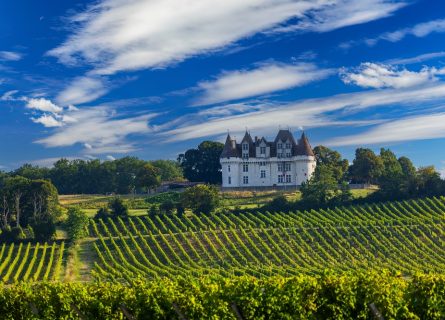
Bergerac thoroughly deserves its reputation as a very tranquil and achingly beautiful wine region. Situated east of Bordeaux (about 100 kilometers), vineyards carpet both sides of the river valley, following the Dordogne as it charts its path into central France.
Distinctive Terroir and Appellations
Within the greater Bergerac region are several important appellations, including the eponymous Bergerac, Côtes de Bergerac, Monbazillac, and Montravel AOCs. As a result, you can expect to encounter a wide variety of wine styles and terroirs in this dynamic wine zone.
Differences from Bordeaux
Yet many oenophiles mistakenly believe that Bergerac is simply an extension of the Bordeaux region – the same soils, climate, grapes, and traditions. However, while there is evidently a crossover in wine style, there are also key differences: the local climate shows more continental flourishes than the Atlantic-influenced Gironde, resulting in colder winters and hotter summers.
Thus, we can broadly describe the wines of Bergerac as having more fruit and opulence than the classic appellations of Bordeaux. However, the latter has endured a succession of very hot vintages. And, much like Saint-Emilion to the west, there is an abundance of clay-limestone in Bergerac, in addition to gravelly clay soils (known locally as boulbènes) and sandy terroir.
Varietal Expressions and Vineyard Characteristics
The area under vine remains extensive, covering about 1200 hectares of vineyards in the southern half of the département. The most important catch-all appellation is Bergerac, producing excellent value red, white, and rosé wines; Cabernet Sauvignon/Merlot blends are the mainstay of life here, while Bergerac Blanc Sec (dry) is a mirror image of Graves Blanc.
Nevertheless, it is a forceful and often pungently aromatic mixture of Semillon and Sauvignon Blanc, two varieties that thrive in the region’s limestone-rich subsoils.
Monbazillac’s Sweet Nectar
But by far, the most impressive white wines are the sweet bottles of nectar made in Monbazillac. Located to the southwest of Bergerac town, Monbazillac stands out as one of the few places in the region where one can reliably count on the botrytis mold to flourish in the foggy mornings of early fall.
Like Sauternes, the vineyards are very close to a tributary (the Gardonette) that flows into the Dordogne; differences in water temperature create the famous mists that carry moisture to the vines. And so, if all goes to plan, fungal spores will begin to attack the berries. Indeed, it is sometimes the case that botrytis can sweep through the vineyards of Monbazillac when there is none in Sauternes.
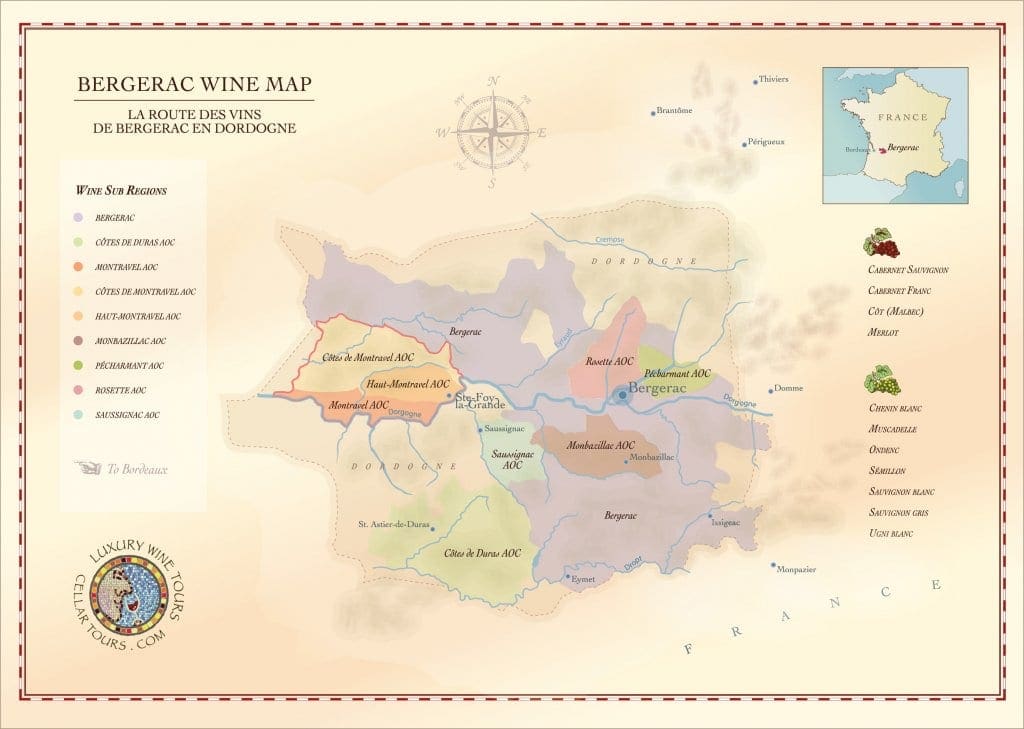
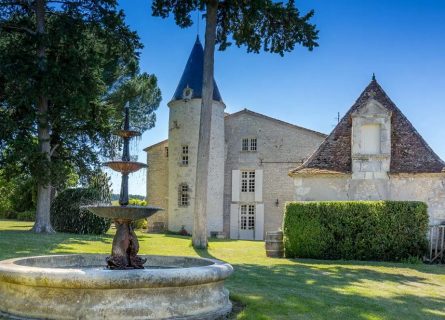
In many ways, the winemaking traditions of the Dordogne are a mirror image of Bordeaux. The appellations Bergerac and Côtes de Bergerac govern the production of red and white blends of Cabernet Sauvignon/Merlot and Sauvignon Blanc/Semillon, respectively; Côtes de Bergerac imposes stricter rules in terms of yield and aging.
Vinification Techniques and Similarities
Nevertheless, in a blind tasting, it can be quite challenging to distinguish Bergerac Sec from Graves Blanc, at least in terms of the vinification techniques used. Leading properties in both regions favor using stainless steel and temperature control, maturing their top cuvées in French oak for around 12-14 months.
Moreover, the best producers in Bergerac and Bordeaux will also use hand-harvested grapes, with a growing predilection for sustainable and organic viticulture.
Characteristics of Bergerac Wines
So where, then, do the differences lie? In broad strokes, the wines of Bergerac tend to be more open and fruit-rich than their equivalents from Bordeaux due to the warmer climate. Indeed, in very dry years like 2018, Bergerac-grown Cabernet Sauvignon has a whiff of Napa Valley about it – the scent of chocolate and velvet texture. The dry whites, meanwhile, offer a surfeit of tropical fruit and moderate acidity, with the smell of new barrique easily detectable in the more top-end wines.
Local Curiosities and Lesser-Known Appellations
However, although Bergerac AOC accounts for the majority of exports today, there are some local curiosities – often tiny appellations of less than 50 hectares -that merit further investigation. For example, hardly anyone outside of the Dordogne, much less in France, knows about the obscure vineyards of Rosette. They occupy a beautiful amphitheater of vines north of the town of Bergerac, planted on exceptional calcareous soils. But only a few winegrowers market their wines under the AOC banner; these Sauternes-inspired blends have noticeably less sweetness than Bordeaux’s premier region and are wonderful alongside tarte aux pommes.
In contrast, the oak-aged dry reds of Pecharmant are a dead ringer for Lalande-de-Pomerol: full-bodied and juicy reds of moderate tannin. In addition, Montravel AOC is now producing some excellent dry whites of exceptional value (same formula as Bergerac Sec), while Côtes de Montravel and Haut-Montravel specialize in sweet styles.
Monbazillac’s Prestige and Evolution
Of course, Monbazillac is the area’s most renowned—and glamorous—sweet wine appellation. In the 1980s, machine harvesting and heavy doses of sulfur dioxide tarnished the zone’s reputation. However, mechanical picking was abandoned in 1993.
Likewise, much lighter doses of sulfur have become the norm, and fermentation is conducted with due diligence in stainless steel or oak barrel. These potent concoctions of Semillion, Sauvignon, and Muscadelle (hardly ever used in Sauternes) create a more powerful, unctuous expression that is commonly encountered in Bordeaux. Monbazillac is thrilling with bottle age: caramel, hazelnuts, and lemon sherbet leap out of the glass. And, best of all, you won’t have to pay First Growth prices.

Historically, the wines of Bergerac were considered distinctly inferior to the top labels and classified estates of Bordeaux. Yet, while it is undoubtedly true that plain and simple Bergerac AOC can be quite pedestrian, standards have risen dramatically across the region over the past 20 years. Today, a critical mass of producers are making the necessary investments – both in the vineyard and cellar – to position Bergerac where it belongs as a worthwhile and good-value alternative to the best wines of the Medoc, Graves, and Saint-Emilion.
Exemplary Producers
However, while the number of exemplary wines grows with every vintage, some standout names deserve our applause. Château Tour de Gendres is an example run by the congenial and supremely talented Luc de Conti. This 52-hectare estate was founded in 1925 at the height of Bergerac’s golden age and has been run by the same family since the early 20th century. Today, the third generation has the reigns – Luc instigated a conversion to biodynamic viticulture in the early 00s, receiving his certification in 2005. This estate has mastered the art of making terroir-driven, authentic red and white wines by cutting yields and eschewing artificial inputs (de Conti does not use sulfur). His unfiltered and super-fresh Bergerac Blanc is among the best in its class – a veritable bargain at under $25.
Philosophy and Approach to Winemaking
Château Saint-Cernin is another property to take very seriously. Its talented oenologist, Lise Sadirac, is helping to transform Bergerac’s reputation with her commitment to sustainability and hands-off winemaking.
Sadirac says:
“My philosophy is simple: do as little as possible so that the grapes are in the spotlight. The grape is the star of the wine. This apparent simplicity is not easy to achieve in reality. Indeed, it is not doing nothing, but it is supporting the vinification and aging to reveal the terroirs.”
Sadirac regards Bergerac’s two most important USPs as “balance and diversity.”
She describes:
“A fantastic diversity of terroirs, especially on the edge and on the limestone of Issigeac, polyculture is applied (wheat fields, cows, walnut trees, woods, and vines coexist) and the winegrowers can plant and care for vines which produce dry white wines, rosés, young reds, wines for aging and of course sweet wines, such as Monbazillac.”
She adds:
“I had never seen so many winegrowing traditions and innovations brought together in a single territory. Our range, in particular, offers more than 15 different wines.”
Elevating Bergerac’s Standing
That’s very true. However, an endless array of styles will not excite consumers if the quality is below par. Thankfully, a combination of lower yields, ethical viticulture, and a more nuanced approach to winemaking is elevating Bergerac in the eyes of both critics and drinkers. These powerfully flavored, well-structured wines can now rival the best of Bordeaux.
Explore the allure of the Semillon grape & its legendary connection to Sauternes. Unveil the history & flavors of this captivating varietal. Cheers!
Find out moreThe sauvignon blanc grape varietal, originally from the Bordeaux region of France, is now one of the world's most loved white varieties.
Find out moreMuscadelle is a white grape varietal, primarily used for blending in the production of sweet white wines in the Bordeaux region.
Find out moreDiscover the irresistible allure of Cabernet Sauvignon—a worldwide favorite with robust, dark-bodied flavor. Unleash your wine journey today!
Find out moreMerlot is the most cultivated grape in Bordeaux and closely related to Cabernet Franc
Find out moreCabernet Franc grape is a close relative of Merlot and Cabernet Sauvignon and is the principal blending grape used in Bordeaux.
Find out more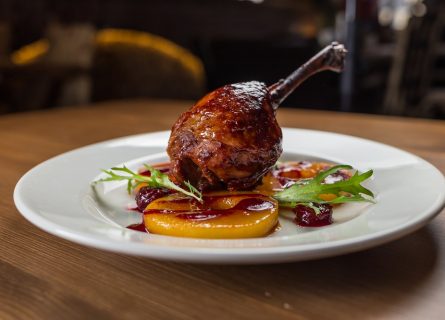
All great wine regions strongly emphasize dining and gastronomy, and Bergerac is no exception. The town’s main claim to fame is the exploits of Savinien Cyrano de Bergerac. However, its cobbled old town, packed with enticing wine bars and restaurants, is far more interesting in our view.
Likewise, the city of Périgueux offers some fantastic options, particularly if you enjoy hearty dishes like Enchaud Périgourdin (pork loin covered in garlic and thyme and slow-roasted in stock), confit de Canard, and pommes Sarraladais—potatoes cooked in duck (or goose) fat and seasoned liberally with garlic and herbs.
A Gastronomic Guide to the Cuisine of the Périgord: Read more
If you would like us to customize an exclusive luxury tour, contact us and let us know your travel plans. We offer luxury food and wine tours for private groups of a mininium two guests. In addition, all of our private, chauffeured tours are available year-round upon request.

